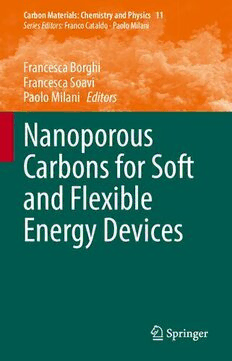
Nanoporous Carbons for Soft and Flexible Energy Devices PDF
Preview Nanoporous Carbons for Soft and Flexible Energy Devices
Carbon Materials: Chemistry and Physics 11 Series Editors: Franco Cataldo · Paolo Milani Francesca Borghi Francesca Soavi Paolo Milani Editors Nanoporous Carbons for Soft and Flexible Energy Devices Carbon Materials: Chemistry and Physics Volume 11 SeriesEditors FrancoCataldo ActiniumChemicalResearchInstitute Roma Italy PaoloMilani DipartimentodiFisicaandCIMAINA UniversityofMilan Milano Italy CarbonMaterials:ChemistryandPhysicsaimstobeacomprehensivebookseries with complete coverage of carbon materials and carbon-rich molecules. From elementalcarbondustintheinterstellarmedium,tothemostspecializedindustrial applications of the elemental carbon and derivatives. With great emphasis on the most advanced and promising applications ranging from electronics to medicinal chemistry. The aim is to offer the reader a book series which not only should be made of self-sufficient reference works, but should stimulate further research and enthusiasm. Forfurthervolumes: http://www.springer.com/series/7825 Francesca Borghi • Francesca Soavi • Paolo Milani Editors Nanoporous Carbons for Soft and Flexible Energy Devices Editors FrancescaBorghi FrancescaSoavi DepartmentofPhysics DepartmentofChemistry“Giacomo UniversityofMilan Ciamician” Milan,Italy AlmaMaterStudiorumUniversityof Bologna PaoloMilani Bologna,Italy DepartmentofPhysics UniversityofMilan Milano,Italy ISSN1875-0745 ISSN1875-0737 (electronic) CarbonMaterials:ChemistryandPhysics ISBN978-3-030-81826-5 ISBN978-3-030-81827-2 (eBook) https://doi.org/10.1007/978-3-030-81827-2 ©TheEditor(s)(ifapplicable)andTheAuthor(s),underexclusivelicensetoSpringerNatureSwitzerland AG2022 Thisworkissubjecttocopyright.AllrightsaresolelyandexclusivelylicensedbythePublisher,whether thewholeorpartofthematerialisconcerned,specificallytherightsoftranslation,reprinting,reuse ofillustrations,recitation,broadcasting,reproductiononmicrofilmsorinanyotherphysicalway,and transmissionorinformationstorageandretrieval,electronicadaptation,computersoftware,orbysimilar ordissimilarmethodologynowknownorhereafterdeveloped. Theuseofgeneraldescriptivenames,registerednames,trademarks,servicemarks,etc.inthispublication doesnotimply,evenintheabsenceofaspecificstatement,thatsuchnamesareexemptfromtherelevant protectivelawsandregulationsandthereforefreeforgeneraluse. Thepublisher,theauthorsandtheeditorsaresafetoassumethattheadviceandinformationinthisbook arebelievedtobetrueandaccurateatthedateofpublication.Neitherthepublishernortheauthorsor theeditorsgiveawarranty,expressedorimplied,withrespecttothematerialcontainedhereinorforany errorsoromissionsthatmayhavebeenmade.Thepublisherremainsneutralwithregardtojurisdictional claimsinpublishedmapsandinstitutionalaffiliations. ThisSpringerimprintispublishedbytheregisteredcompanySpringerNatureSwitzerlandAG Theregisteredcompanyaddressis:Gewerbestrasse11,6330Cham,Switzerland Preface The rapidly increasing demand for flexible electronics, portable energy harvest- ing/storagesystems,autonomoussensors,softrobotics,andwearableandbiomed- ical devices has stimulated the need of electrode materials to be integrated on nonconventionalsubstratessuchasflexibleandsoftpolymers,textiles,fabrics,and biomaterials. Thelowcost,abundance,andfacileprocessingroutesmakenanoporouscarbon electrodes ideal candidate for these applications. In fact, the structural properties of carbon-based nanomaterials in terms of porosity, specific surface area, and phase,combinedwiththeirmechanical,conductive,andcatalyticproperties,show promising results for a wide range of applications where soft, autonomous, and sustainablesystemsarenecessary. This book provides a timely and in-depth review of some of the main topics and trends about the use of carbonaceous materials as high performing and cost- effective ingredients for large scale technological implementation of devices. In order to serve as a reference source for a multidisciplinary community working at thedevelopmentofsensors,energyharvestingandstoragedevices,actuators,etc.,in thisbook,wefocusourattentiontotheelectricalandstructuralpropertiesofporous carbonaceous materials, and how production and characterization approaches can leadtosystemswithtailoredproperties.Inparticular,weconcentratedonenhanced interfacialinteractionsbetweenfluidsandthesolidwallsofthematerialspromoted bythehighsurfaceareaavailableintheporousmatrix. Thisbookaddressessystemsrelevantforautonomousdevicesrequiringefficient energy production and managing such as carbon-based flexible electronics with reduced power consumption. Carbon fiber electrodes are promising materials to be integrated into flexible batteries and carbon nanotubes-based flexible dual- material gate (DMG) technology. Carbon-based ion-gated transistors (IGTs) are alsopresentedasenablingingredientforthefabricationofenergyharvester/storage microsystems due to their low-voltage operational characteristics, in view of the developmentofautonomoussensorswithmultiplefunctionalitiesonasinglechip, thatis,SystemsonaChip(SoC). v vi Preface A very important issue is the sustainable production of energy: the case of car- bonaceousmaterialsintegratedintomicrobialfuelcellsispresentedanddiscussed inviewofscale-upofthistechnology.Thefocuswillbeonthemostrecentfindings andincorporationoflightweight,robust,andbiocompatiblecarbonfiberelectrodes in the form of carbon veil both as the anode and cathode counterparts and their suitabilityinlarger-scaledesigns. Fabrication methods allowing to control the internal and external structure of the functional properties carbon-based systems will be discussed with particular attention to carbon-based filler and matrices integrated into sensor architectures. Solutionsenabledbysmartproductionapproachessuchaslaser-inducedgraphene (LIG) for stretchable applications in soft piezoresistive, electrophysiological, and electrochemicalsensorsarealsopresented. Finally, the last two chapters discuss and summarize the characterization of porous carbon films’ growth mechanisms highlighting the achievement of the fine control of the morphological properties that regulate mass transfer rates in catalytic devices, electron diffusion pathway in dye-sensitize solar cells, double- layerorganizationoftheelectrolyteinelectrochemicaldevices,andperformanceof gassensors. Milan,Italy FrancescaBorghi Bologna,Italy FrancescaSoavi Milan,Italy PaoloMilani Contents 1 CarbonNanotubesforFlexibleFiberBatteries .......................... 1 YeZhang,TingtingYe,LuheLi,andHuishengPeng 2 CarbonNanotubeDual-MaterialGateDevicesforFlexible Electronics.................................................................... 23 LiXiangandYoufanHu 3 Integration of Cost-Efficient Carbon Electrodes into theDevelopmentofMicrobialFuelCells.................................. 43 JiseonYou,IwonaGajda,JohnGreenman,andIoannisA.Ieropoulos 4 BridgingElectronicsandMicroEnergyStorage......................... 59 AlexanderMasson,FedericoPoli,FrancescaSoavi,andClaraSantato 5 NanoporousCompositeSensors............................................ 85 AdebayoEisape,BohanSun,JingLi,andSungHoonKang 6 Laser-InducedGrapheneandItsApplicationsinSoft(Bio)Sensors... 111 AlexanderDallinger,KirillKeller,andFrancescoGreco 7 ProductionofCarbonNanofoambyPulsedLaserDeposition onFlexibleSubstrates ....................................................... 135 AlessandraMaffini,AndreaPazzaglia,DavidDellasega,ValeriaRusso, andMatteoPassoni 8 PorosityofNanostructuredCarbonThinFilms.......................... 159 Alessandra Del Giudice, Giulio Benetti, Claudio Piazzoni, andFrancescaBorghi Index............................................................................... 181 vii Acronym and Symbols 3D Threedimensional AC Activatedcarbon Al Aluminium ATP Adenosinetriphosphate Au Gold BET Brunauer–Emmett–Teller CNT Carbonnanotube CV Carbonveil DIBL Drain-inducedbarrierlowering DMG Dual-materialgate FET Fieldeffecttransistor GAC Granularactivatedcarbon GDL Gasdiffusionlayer IC Integratedcircuit I On-currentofdiode diode-on I Off-statecurrent off I On-statecurrent on I-Vcurve Current-voltagecharacteristiccurves L Lengthofthedevicechannel MFC Microbialfuelcell MOSFET Metal-oxide-semiconductorfieldeffecttransistor NASA NationalAeronauticsandSpaceAdministration,USA NG Normal-gated OCV Opencircuitvoltage ORR Oxygenreductionreaction PANI Polyaniline Pd Palladium PTFE Polytetrafluoroethylene PVA Polyvinylalcohol PVDF Polyvinylidenedifluoride SEM Scanningelectronmicroscopy ix x AcronymandSymbols SS Subthresholdswing Ti Titanium V Controllingsignal ctrl V Inputsignalappliedondrainelectrode d-in V Drain-to-sourcevoltage ds V Inputsignalappliedongateelectrode g-in V Gate-to-sourcevoltage gs V Outputsignal out V Thresholdvoltage th W Widthofthedevicechannel Y Yttrium
